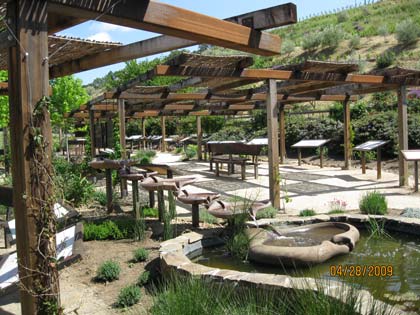
Up near Organic, right after you go Green, past the lawn-mowing sheep, estate-raised insects and vats of compost “tea,” you come to what is, for the wine industry, a path less taken. At Benziger Family Winery, it’s known as The Biodynamic Discovery Trail.
Developing new approaches to grape growing, winemaking and land preservation, it turns out, was no walk in the park.
The new trail is a self-guided tour about the history and practical use of biodynamic farming. It’s a flat, easily walked 15-minute diversion just off the winery parking lot. Admission is free.
Descriptive signs, photos and illustrations are posted in four “pods” within the landscaped area. The trail, perhaps a winding 100 yards in all, is partially covered by latticed frames made from vine cuttings. Native plants, and some of the estate’s 32 kinds of fruits and vegetables, dot islands of earth. A multi-stage fountain plays into a rock-rimmed pond. A vineyard’s gentle slope ends at one fence, and past the other, a terraced planting of grapes and lavender.
Perhaps it was this kind of bliss Rudolph Steiner envisioned when he developed the principles of biodynamic farming in the 1920s. Even then, before “big chemical” came along, Steiner advocated the return to a time when the farmer nurtured the land and the land nourished the community.
“People think we’re a bunch of hippie farmers making it up as we go along,” said Colby Eierman, Benziger’s director of sustainability. “But it’s really Biodynamics 101. Think of your farm as a living organism.”
Okay, then. The farm’s own custom water-treatment facility might be the digestive system. And the homeopathic applications – brews of compost spiked with various plants and bark – along with native birds and insects would help build the immune system.
The care is holistic and increasingly labor intensive. During the year’s growth cycle, each grape vine is touched by human hands up to 17 times, Eierman estimates. “It’s people working the land on a garden scale.”
While employing some admittedly “esoteric practices” – burying a cow horn stuffed with manure, for example –there’s hard science thrown in with the folklore. The winery uses satellite imagery to monitor soil moisture and portable weather stations to detect microclimates.
Somehow it all comes down to a personal connection to the land. Eierman credits Mike Benziger, the force behind the move to biodynamic farming, as the first to get the vibe. In the mid ‘90s, walking in the vineyards one day, Benziger noticed an odd stillness. He didn’t hear birds or see insects. The grape-growing practices of the day had taken the life from the land. The vital connection had been broken.
Piece by piece they’ve been putting it back ever since. And if what makes a wine unique is its expression of place, embracing biodynamics is more than good stewardship. It’s good business. Apparently, you can have your rice cake and eat it, too.
Hot on the trail of biodynamic farming at Benziger Family Winery
More from FeaturesMore posts in Features »




